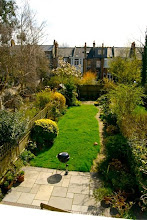

Here's a piece I wrote for
Saturday's Telegraph on the latest wave of Chanel biographies... the picture (above) is by a wonderful photographer,
Shahrokh Hatami, one of the few to come close to capturing Chanel...
Given that five was Coco Chanel’s lucky number – not least because she saw it as synonymous with her best-selling perfume – she might have been pleased, as well as amused, to see that she is the subject of a quintet of new books this autumn. As the author of a previous biography of Chanel, I should, perhaps, be dismayed at the arrival of competitors. I’d like to think that mine is the only book required by those in search of the truth about Chanel; but one of the many mysteries of Chanel – the most elusive of women – is that people seem always to want more of her, rather than less (which is itself an intriguing conundrum, given her legacy of streamlined modernism, in sartorial matters, if nothing else).
Of the various stories told about Coco Chanel – born Gabrielle, misidentified as Chasnel, the illegitimate daughter of an itinerant market trader, in a provincial French poorhouse in 1883 – a great number were invented by herself. These legends were to be the undoing of the earliest of her biographies (ghosted memoirs commissioned by Mademoiselle Chanel, but never completed or published, always smothered by her at birth when she realized that the truth was less compelling, at least to her, than the self-invented creation myth). They also permeate the recollections published after her death in 1971, including ‘L’Allure de Chanel’ by her friend Paul Morand, which repeats the fairytale that she was raised by aunts, in the wake of her mother’s death. In fact (not that facts are readily available to those seeking uncover the realities of her childhood), Chanel had been abandoned by her father, along with her two sisters, in an orphanage run by nuns at Aubazine, a medieval Cistercian abbey in an isolated region of Corrèze. From these remote beginnings, via a shadowy period as seamstress, shop-girl, music-hall singer and mistress, Chanel made her way to Paris, and fame.
The fairytale remains sufficiently compelling for writers, as well as readers, to wish to make it their own; a myriad reinterpretations and variations, all of them woven out of Chanel’s raw material. Given the afterlife of her classic designs that still prevail in her own (now globally recognized) label, not to mention all the other brands, we should not be surprised; simply consider the lasting appeal and reinvention of her little black dresses, soft tweed jackets, chain straps on quilted handbags, stripy tops, pearls, camellias. Each of these can be linked to Chanel’s past: black as the colour of mourning, remade into a symbol of female independence; pearls akin to the rosary beads of the nuns that taught her to pray, and to sew; chains like the ones worn around their waists; white camellias in recognition of La Dame aux Camellias, the archetypal courtesan who died of consumption (as did her mother); tweed from the sporting garb of her lover, the Duke of Westminster; sailor stripes and trousers from her Riviera escapades.
So far this season, I have been reading these five new books, in between marvelling at the way Chanel’s language of fashion continues to shape the latest collections (just look at the Jazz Age dresses and Coco white collars atop black sweaters). Two are by serious academics: Amy de la Haye’s ‘Chanel: Couture and Industry’ (V&A Publishing) and Linda Simon’s ‘Coco Chanel’ (one of the Critical Lives series published by Reaktion); the author of the former is a professor at the London College of Fashion, the latter an English professor in New York, and both are an indication of the central status that Chanel occupies in the history and culture of the 20th century.
As for the others – Hal Vaughan’s headline grabbing account that depicts Chanel as a Nazi agent, Lisa Chaney’s ‘An Intimate Life’, and Isabelle Fiemeyer’s ‘Intimate Chanel’ – well, where to begin? I am not convinced by Vaughan’s interpretation of Intelligence sources (we have both spent much time researching military archives, but draw differing conclusions; my own view about Chanel’s wartime activities is somewhat less sensational than his, although I hope more subtle and nuanced). Of the two biographies that promise intimate truths, Chaney’s text is undeniably thorough, but Fiemeyer has the distinct advantage of having collaborated with Chanel’s closest surviving relative, her great niece Gabrielle Palasse-Labrunie, who knew her well.
Gabrielle the younger, born in 1926 (and rumoured by some to have been Chanel’s granddaughter; her father, Andre Palasse, officially Chanel’s nephew, was certainly as close as a son -- of which more in my book) was enormously helpful to me in my researches, and her memories and inheritance are displayed again here. The unhappiness of Chanel’s past is made clear – both of Coco’s sisters committed suicide, according to Madame Labrunie – but perhaps most intriguing of all are the photographs of the talismans that Chanel held most dear. If her life and work was shaped by magical signs and symbols (numerology, tarot, with the dead always close at hand), then some of her esotericism was passed on by her first great love, Boy Capel, as is evident in his handwritten notebook that she treasured after his death in a car-crash in 1919. This contains fragments from sacred texts – including theosophy, alchemy, Masonic secrets – and provides an intriguing context to Chanel’s jewellery collection, including the Egyptian medallion that she wore constantly and the child’s ring with which she was buried.
But in the end, however closely we may study these and other precious objects – and I wrote several chapters of my book surrounded by some of them, working at Chanel’s own desk in her private apartment – no one can ever fully possess Chanel, although she continues in her remarkable possession of us…








































